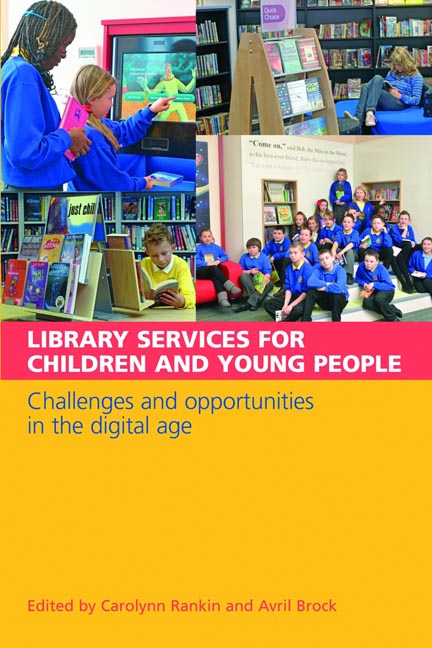Book contents
- Frontmatter
- Dedication
- Contents
- Contributors
- Foreword
- Acknowledgements
- Introduction and vision for the book
- Part 1 Children's library services – policy, people and partnerships
- Part 2 Connecting and engaging – reaching your audience and catching the latest wave
- 5 Libraries, literacy and popular culture – let's get reading!
- 6 Libraries, literacy and popular culture – what's cool to read?
- 7 Creative integration of information technology in the school library
- 8 Comics, manga and graphic novels – developing, selecting and promoting a core collection for teenagers and young people
- 9 Connecting and engaging with children and young people – the Australian public library perspective on outreach and marketing
- 10 Case study. Partnerships and library outreach in the National Year of Reading 2008
- Part 3 Buildings, design and spaces – libraries for children and young people
- Part 4 Issues for professional practice
- Index
9 - Connecting and engaging with children and young people – the Australian public library perspective on outreach and marketing
from Part 2 - Connecting and engaging – reaching your audience and catching the latest wave
Published online by Cambridge University Press: 08 June 2018
- Frontmatter
- Dedication
- Contents
- Contributors
- Foreword
- Acknowledgements
- Introduction and vision for the book
- Part 1 Children's library services – policy, people and partnerships
- Part 2 Connecting and engaging – reaching your audience and catching the latest wave
- 5 Libraries, literacy and popular culture – let's get reading!
- 6 Libraries, literacy and popular culture – what's cool to read?
- 7 Creative integration of information technology in the school library
- 8 Comics, manga and graphic novels – developing, selecting and promoting a core collection for teenagers and young people
- 9 Connecting and engaging with children and young people – the Australian public library perspective on outreach and marketing
- 10 Case study. Partnerships and library outreach in the National Year of Reading 2008
- Part 3 Buildings, design and spaces – libraries for children and young people
- Part 4 Issues for professional practice
- Index
Summary
Introduction and background Australia is a geographically vast country, with a relatively small population of approximately 22 million. Most of the population lives in the major cities, which are situated on the coastline. Australia is a very multicultural nation, with 25% of people born overseas, while indigenous Australians make up only 2.4% of the population (Australian Bureau of Statistics, 2010). Despite the overall aging of the population, children and young people still account for approximately onethird of the Australian population (Australian Institute of Health and Welfare, 2009, 1).The country has a three-tier government system – federal, state and local – and while models vary from state to state, in most cases, public libraries are funded by local government, with a small amount of state funding. The benefit of this system is that local programmes can be targeted specifically to local issues, but it can also make it difficult to run large-scale services, which would be an advantage to the whole population. Public library outreach and marketing is all about connecting and engaging with local communities, finding out what they want and attempting to match services and resources to those needs, as well as to the funding body's mission. The other key components involve promoting those services back to the community, physically running the event or delivering the service and then adequately evaluating it afterwards. This process is always a juggling act between community needs and expectations, budget and time constraints, the mission of the funding organizations and the skills and expertise of staff and partnering organizations. In Australia, some of the key considerations in connecting and engaging communities are geographic distance and isolation, language, socio-economic and cultural barriers, and access and equity issues.
Librarians have become increasingly aware of the important role that public libraries play in building social capital in their local communities. Libraries are a logical point of community intersection and interaction. They give people in the local community access to the increasingly technological world of information. This is particularly important for children and young people, who can be disengaged from school and the community, due to family stress, poverty, literacy and language barriers. Libraries can provide a space with resources and support in a non-judgemental environment, which gives young people the opportunity to dream and achieve (Bourke, 2005).
- Type
- Chapter
- Information
- Library Services for Children and Young PeopleChallenges and opportunities in the digital age, pp. 129 - 142Publisher: FacetPrint publication year: 2012



